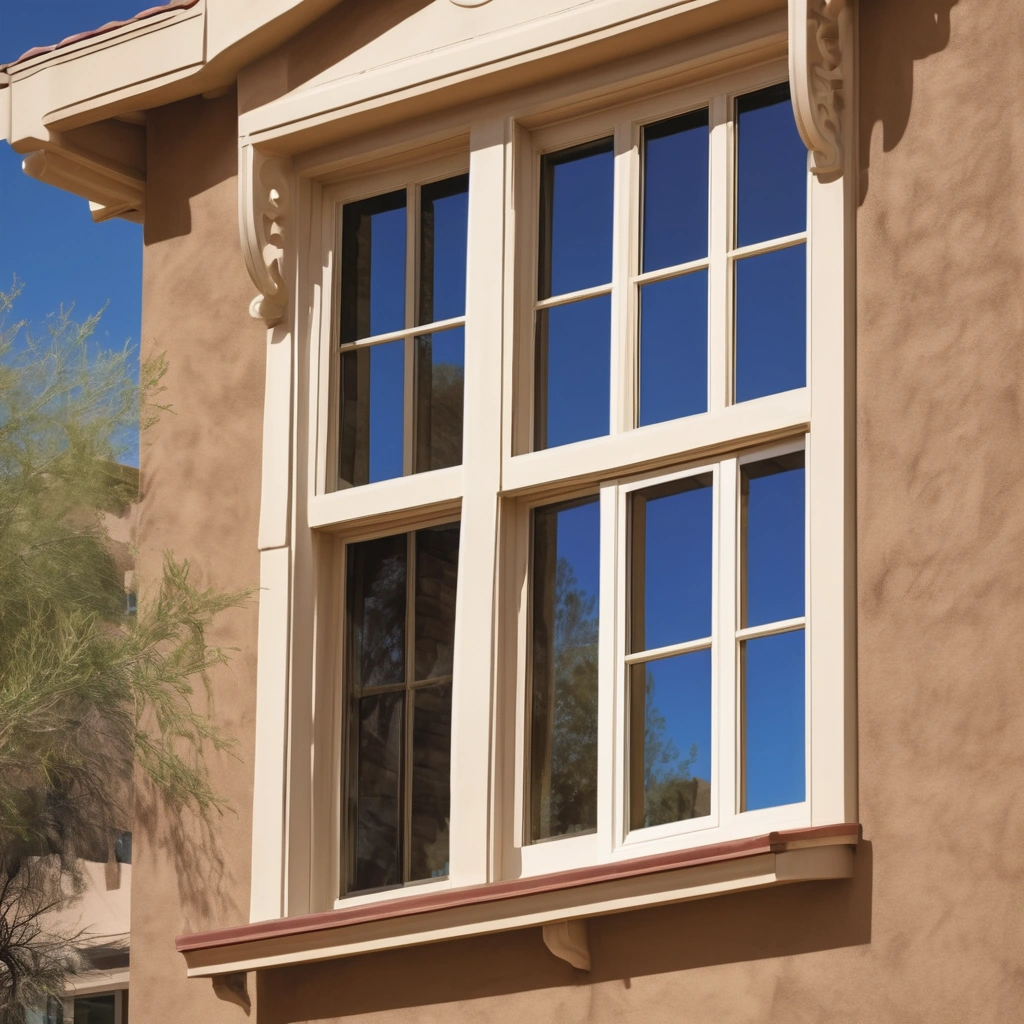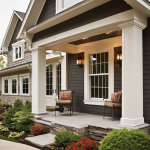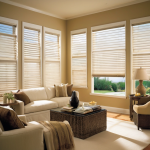Choosing the Right Windows for Arizona Homes: A 2024 Guide to Energy Efficiency, Style, and Cost in Desert Climates
Introduction: The Arizona Window Challenge
Arizona’s intense desert climate presents unique challenges for homeowners, particularly when it comes to Arizona windows. Scorching summers, relentless UV rays, and persistent dust storms demand careful consideration when selecting windows for Arizona homes. Choosing the right energy-efficient windows isn’t just about aesthetics; it’s about energy efficiency, comfort, and protecting your investment in your Arizona home. This guide provides a comprehensive overview of window options tailored for Arizona homes in 2024, helping you navigate the complexities of energy ratings, materials, window styles, and costs to make an informed decision regarding window replacement.
We’ll explore how to balance energy savings with your desired aesthetic and budget, ensuring your home remains a cool, comfortable oasis year-round. The selection of desert climate windows requires a deep understanding of metrics like the Solar Heat Gain Coefficient (SHGC) and U-factor. These ratings, often found on energy-efficient windows, quantify how well a window blocks solar heat and prevents heat transfer, respectively. For Arizona homes, prioritizing low SHGC values is crucial to minimize heat gain during the summer months.
Investing in high-quality window materials and low-E glass can significantly reduce energy consumption, leading to lower utility bills and a more comfortable living environment. Consider factors such as proper window installation to ensure optimal performance and longevity. Beyond energy efficiency, the right window styles can dramatically enhance the curb appeal and value of Arizona homes. From classic double-hung windows to modern casement and sliding options, the choices are vast. Selecting window materials that withstand the harsh desert climate is equally important. Vinyl windows offer a cost-effective and durable option, while fiberglass windows provide superior strength and insulation. Wood windows, while aesthetically pleasing, require more maintenance to prevent warping and cracking in the dry Arizona heat. Ultimately, the best window replacement choice involves carefully weighing aesthetic preferences, performance characteristics, and budget considerations.
Understanding Arizona’s Climate Challenges
Arizona’s desert climate presents three primary challenges for windows: heat gain, UV exposure, and dust infiltration. Heat gain, the most significant concern for Arizona homeowners, occurs when solar radiation penetrates the glass, behaving much like a miniature greenhouse inside your home. This phenomenon drastically increases interior temperatures, forcing air conditioning systems to work overtime and leading to exorbitant energy bills. Selecting energy-efficient windows is paramount to mitigating this effect; look for low Solar Heat Gain Coefficient (SHGC) ratings to minimize solar heat gain.
Failing to address heat gain can negate the benefits of other energy-saving measures in your Arizona homes. Beyond heat gain, UV exposure poses a serious threat to both your home’s interior and your health. The relentless Arizona sun can fade furniture, damage delicate window coverings, and even degrade interior paint over time. More importantly, prolonged UV exposure can contribute to skin damage and other health concerns. Investing in Arizona windows with advanced UV protection, such as low-E glass with UV-blocking capabilities, is crucial for preserving your home’s aesthetics and safeguarding your well-being.
The impact of UV exposure is often underestimated, but it represents a significant long-term cost if left unaddressed. Dust infiltration, an ever-present reality in the desert climate, presents another persistent challenge. Carried by frequent and often intense winds, dust particles can seep through even the smallest gaps in poorly sealed windows. This leads to constant cleaning, premature wear on window mechanisms, and potential respiratory irritation. Choosing window styles known for their airtight seals, such as casement or awning windows, is essential.
Furthermore, proper window installation is crucial to prevent air and dust leakage. Addressing dust infiltration not only improves indoor air quality but also extends the lifespan of your window investment. For effective desert climate windows, prioritize both material and installation quality. To effectively combat these challenges, Arizona windows must possess a trifecta of protective features: exceptional insulation to minimize heat transfer (low U-factor), advanced UV protection to block harmful rays, and airtight seals to prevent dust and air leakage. Consider options like dual-pane or triple-pane windows with low-E coatings specifically designed for hot climates. Furthermore, the window materials themselves play a vital role; fiberglass and vinyl frames offer excellent insulation and resistance to the harsh desert environment. By carefully considering these factors, Arizona homeowners can select energy-efficient windows that provide lasting comfort, protection, and value, making window replacement a worthwhile investment.
Window Styles and Materials: Performance and Aesthetics
Various window styles offer distinct advantages and disadvantages in the Arizona climate, impacting both energy efficiency and aesthetics. Casement and awning windows, known for their airtight seals when closed, are particularly effective at preventing air leakage and dust infiltration, a significant concern in Arizona’s dusty environment. Double-hung windows, while a classic choice for many Arizona homes, can be prone to air leakage if not properly maintained; investing in high-quality weather stripping and ensuring proper installation are crucial for optimal performance.
Sliding windows offer good ventilation, allowing homeowners to capture those cooler desert evenings, but may not seal as tightly as casement styles, potentially leading to increased energy costs over time. Picture windows maximize views of the stunning Arizona landscape but can contribute significantly to heat gain if not equipped with appropriate glazing technologies like low-E coatings. Specialty shapes, while aesthetically pleasing and adding architectural interest, often require custom solutions and can be more expensive, requiring careful consideration of both budget and energy performance.
Popular window materials each present a unique set of characteristics to consider for Arizona homes. Vinyl windows are cost-effective, energy-efficient, and low-maintenance, making them a popular choice for many homeowners looking for affordable window replacement options. Aluminum windows are durable and strong, able to withstand the harsh Arizona sun, but conduct heat readily, requiring thermal breaks to improve energy performance and prevent excessive heat transfer; thermally broken aluminum frames are a must in desert climates.
Wood windows offer a classic aesthetic that complements many Arizona home styles but require regular maintenance to prevent rot and insect damage, particularly important given the intense sun and occasional monsoon season. Fiberglass windows combine the strength of aluminum with the insulation of wood, offering excellent durability and energy efficiency, making them a premium choice for Arizona homeowners seeking long-term value, albeit at a higher initial price point. When selecting windows for Arizona homes, understanding key performance metrics is essential.
The Solar Heat Gain Coefficient (SHGC) measures how much solar radiation passes through the window; in Arizona, a low SHGC is desirable to minimize heat gain. Similarly, the U-factor indicates the rate of heat transfer; a lower U-factor signifies better insulation. According to the Efficient Windows Collaborative, selecting windows with low SHGC and U-factor ratings can significantly reduce cooling costs in hot climates. Beyond the window itself, proper window installation is paramount. “Even the most energy-efficient window will perform poorly if it’s not installed correctly,” notes Sarah Jones, a certified window installer in Phoenix. “Air leaks around the frame can negate any energy savings.” Investing in professional window installation is crucial to maximizing the benefits of your new Arizona windows.
Coatings and Glazing: Maximizing Energy Savings
Window coatings and glazing options are paramount when optimizing energy efficiency in Arizona homes. Low-E (low-emissivity) coatings work by reflecting infrared light, effectively reducing heat transfer. This keeps homes cooler during scorching summers and helps retain heat during cooler winter months, minimizing reliance on HVAC systems. Tinted glass offers another layer of defense, reducing glare and solar heat gain. However, homeowners should be aware that tinted glass can darken interiors, potentially requiring adjustments to lighting.
Dual-pane windows, constructed with two panes of glass separated by an insulating gas like argon or krypton, drastically reduce heat transfer compared to single-pane alternatives. Triple-pane windows provide even superior insulation, but the increased cost may not always justify the incremental energy savings in Arizona’s climate. For most Arizona homes, energy-efficient windows featuring dual-pane construction and a low-E coating strike an optimal balance between cost and performance. Understanding key performance metrics like the Solar Heat Gain Coefficient (SHGC) and U-factor is crucial for selecting the right Arizona windows.
The SHGC measures the fraction of solar radiation that enters through a window; lower SHGC values signify better heat rejection, a critical factor for desert climate windows. Windows with a low SHGC rating are particularly beneficial for south- and west-facing windows that receive intense direct sunlight. U-factor, on the other hand, quantifies the rate of heat transfer through a window; lower U-factors indicate superior insulation. When considering window replacement, homeowners should prioritize energy-efficient windows with both low SHGC and U-factor ratings to maximize energy savings and comfort.
According to the Efficient Windows Collaborative, selecting windows with appropriate SHGC and U-factor ratings can reduce energy bills by 10-25% annually. Beyond the glass itself, the quality of window installation significantly impacts overall energy efficiency. Even the most advanced low-E glass and high-performing window materials will underperform if not properly installed. Air leaks around the window frame can negate the benefits of energy-efficient windows, allowing heat to enter during summer and escape during winter. Professional window installation ensures a tight seal, preventing air infiltration and maximizing energy savings. When evaluating window styles, consider options like casement and awning windows, which offer inherently tighter seals compared to sliding or double-hung windows. Ultimately, selecting the right combination of window materials, coatings, and professional window installation is essential for creating comfortable and energy-efficient Arizona homes.
Balancing Energy Efficiency, Style, and Budget
Balancing energy efficiency, style, and budget is paramount when selecting Arizona windows for your home. Begin by thoroughly assessing your specific needs and priorities, considering factors such as the age of your home, its orientation, and your long-term energy goals. South- and west-facing windows, which bear the brunt of the Arizona sun, demand windows with superior heat-reducing features like low-E glass and high SHGC (Solar Heat Gain Coefficient) ratings. Conversely, north-facing windows may prioritize maximizing natural light without excessive heat gain.
Remember, the initial cost of window replacement is an investment that pays dividends in reduced energy bills and increased home comfort over time. Prioritizing energy-efficient windows upfront can save significant money in the long run, making them a wise choice for Arizona homes. Navigating the stylistic considerations of window replacement requires careful attention to detail and adherence to community standards. Many Arizona homes are governed by Homeowner’s Associations (HOAs) that may dictate acceptable window styles, materials, and even colors.
Before making any decisions, thoroughly research your HOA’s regulations to avoid potential violations and costly rework. Beyond HOA restrictions, consider the architectural style of your home and choose window styles that complement its design. For example, a modern home might benefit from sleek, minimalist window designs, while a traditional home may call for more ornate options. Selecting window materials that harmonize with your home’s exterior, such as fiberglass or wood, can enhance its curb appeal and overall value.
Securing competitive quotes from multiple window installers is a critical step in the window replacement process. Obtain detailed estimates from at least three different companies, ensuring that each quote includes the cost of windows, materials, labor, and any applicable permits. Compare not only the prices but also the warranties offered by each installer. A reputable window installation company will stand behind its work with a comprehensive warranty that covers both the windows themselves and the installation process. Don’t hesitate to ask about energy efficiency rebates or tax credits that may be available from your local utility company or the federal government. Local Arizona windows installers can provide invaluable insights into the best window options for your specific location and microclimate, helping you make an informed decision that balances energy efficiency, style, and budget.
Cost Comparison: Window Types and Materials
The cost of window replacement in Arizona varies significantly, influenced by window style, material, size, and the intricacies of installation. Vinyl windows generally represent the most budget-friendly option, while fiberglass and wood windows command a higher price point due to their enhanced durability and aesthetic appeal. Installation costs themselves can fluctuate from $100 to $500 per window, contingent upon the installer’s rates, the project’s scope, and any necessary modifications to the window opening. Expect to incur additional expenses for custom window sizes or specialty shapes designed to complement unique architectural features of Arizona homes.
These factors all contribute to the final cost of upgrading your Arizona windows. Here’s a general cost comparison (including installation), keeping in mind that these are broad estimates and actual prices can vary based on specific brands, features like low-E glass, and contractor pricing: Vinyl: $300 – $700 per window; Aluminum: $400 – $800 per window; Wood: $700 – $1200 per window; Fiberglass: $800 – $1500 per window. When considering energy-efficient windows, remember to factor in long-term savings on utility bills.
Windows with a low SHGC (Solar Heat Gain Coefficient) and U-factor will reduce heat transfer, keeping your home cooler in the intense desert climate. Investing in quality window materials and professional window installation can significantly impact your home’s energy performance and overall value. Beyond the initial purchase price, consider the long-term return on investment. Energy-efficient windows, particularly those with low-E coatings designed for the Arizona climate, can significantly reduce cooling costs during the scorching summers.
For instance, replacing single-pane windows with dual-pane, low-E glass windows can lead to a noticeable decrease in monthly energy bills. Furthermore, certain window materials, like fiberglass, offer superior insulation and resistance to warping or cracking under extreme temperatures, reducing the need for frequent repairs or replacements. Before committing to a specific window type, it’s wise to consult with a local window replacement expert familiar with the unique challenges and opportunities presented by Arizona homes. Always obtain multiple quotes from reputable installers to ensure competitive pricing and quality workmanship.
Conclusion: Making the Right Choice for Your Home
Choosing the right Arizona windows for your home is a significant investment, one that resonates far beyond mere aesthetics. It’s about creating a comfortable, energy-efficient living space tailored to the unique demands of the desert climate. Prioritize energy efficiency by meticulously researching window styles and materials, paying close attention to crucial energy ratings like U-factor and SHGC. Low-E glass coatings are indispensable for minimizing heat gain, and understanding the nuances of SHGC (Solar Heat Gain Coefficient) is vital for controlling the amount of solar radiation entering your Arizona homes.
Remember, selecting the right energy-efficient windows directly impacts your long-term comfort and energy savings. Beyond the technical specifications, consider the long-term implications of your window replacement project. Proper window installation is paramount; even the most advanced desert climate windows will underperform if not installed correctly. Seek out certified window installation professionals with experience in Arizona homes. These experts can ensure a perfect seal, preventing air leaks and dust infiltration that can compromise energy efficiency and indoor air quality.
Furthermore, explore available rebates and incentives for energy-efficient upgrades, which can significantly offset the initial investment in new windows. Remember to factor in the lifecycle cost, including maintenance and potential repairs, when comparing different window materials. Finally, don’t underestimate the impact of your window choices on your home’s overall value and curb appeal. While energy efficiency is crucial, selecting window materials and styles that complement your home’s architectural design is equally important. Consider the aesthetic appeal of different window materials, such as vinyl, fiberglass, or wood, and how they integrate with your home’s existing style. Obtain quotes from multiple local window professionals, carefully comparing their prices, warranties, and customer reviews. Ultimately, making the right choice for your specific needs and budget requires a holistic approach, balancing energy performance, aesthetic considerations, and long-term value. Contact a reputable local window installer or energy efficiency specialist today to embark on your window replacement journey and transform your Arizona home into a haven of comfort and efficiency.


